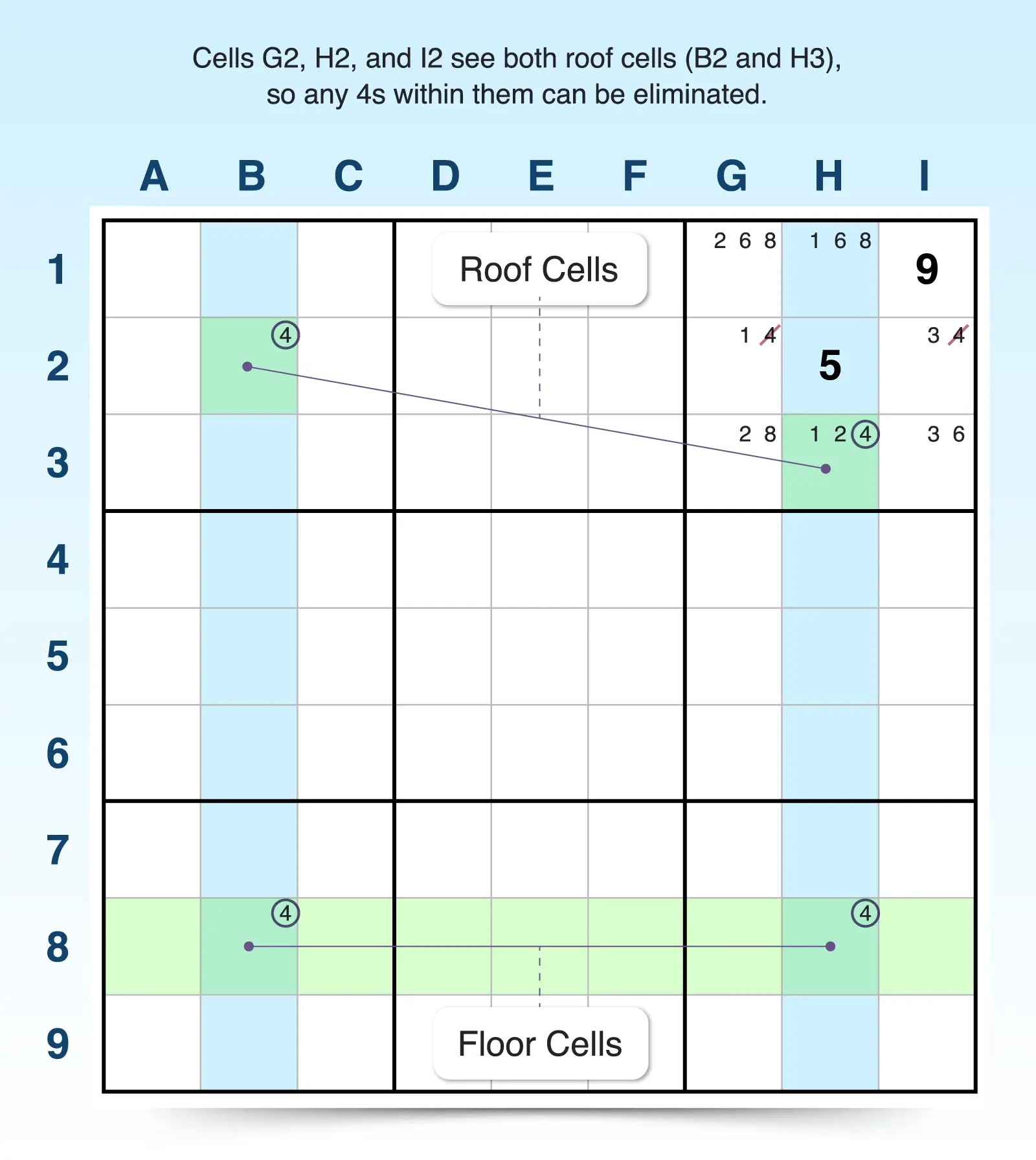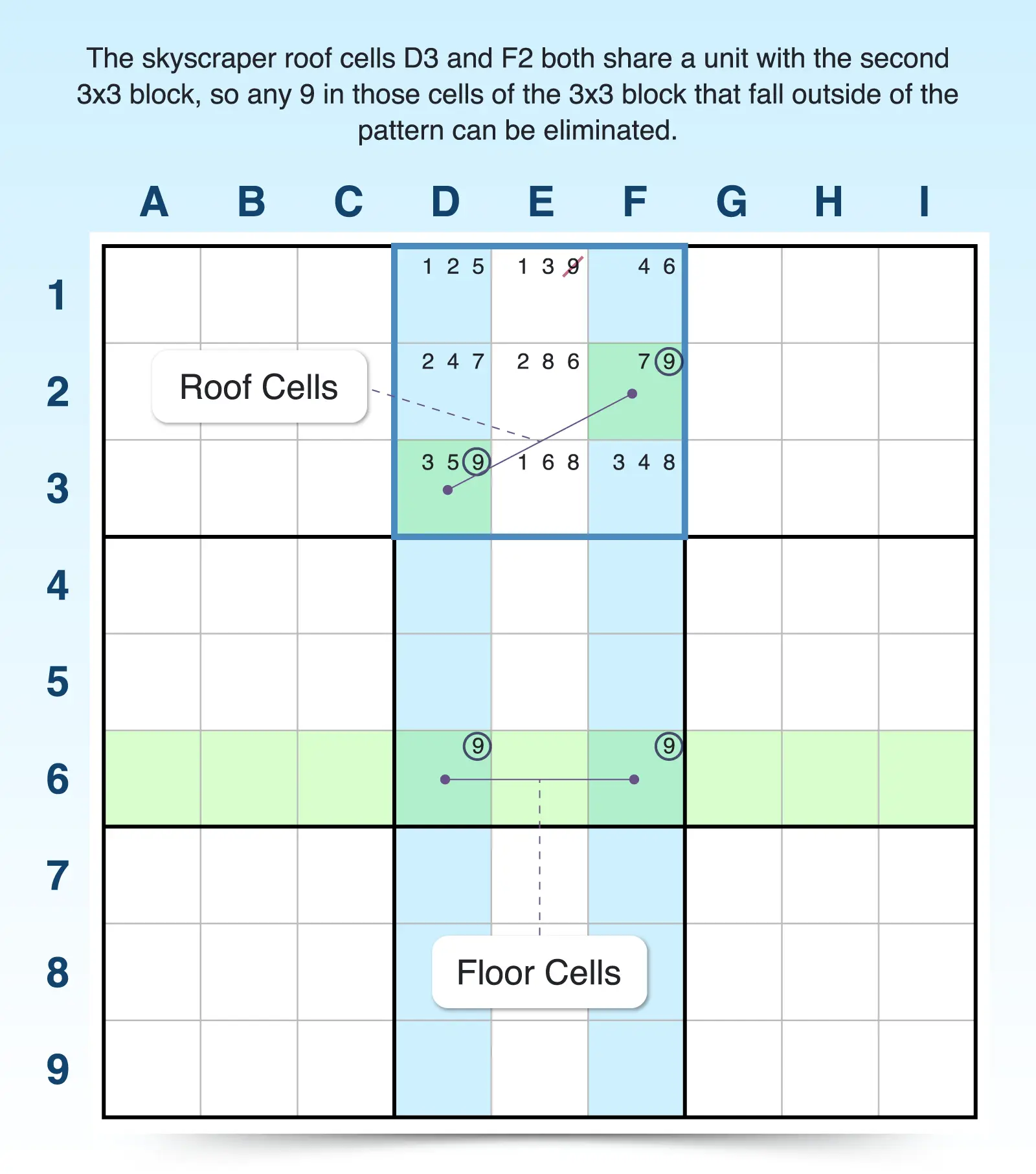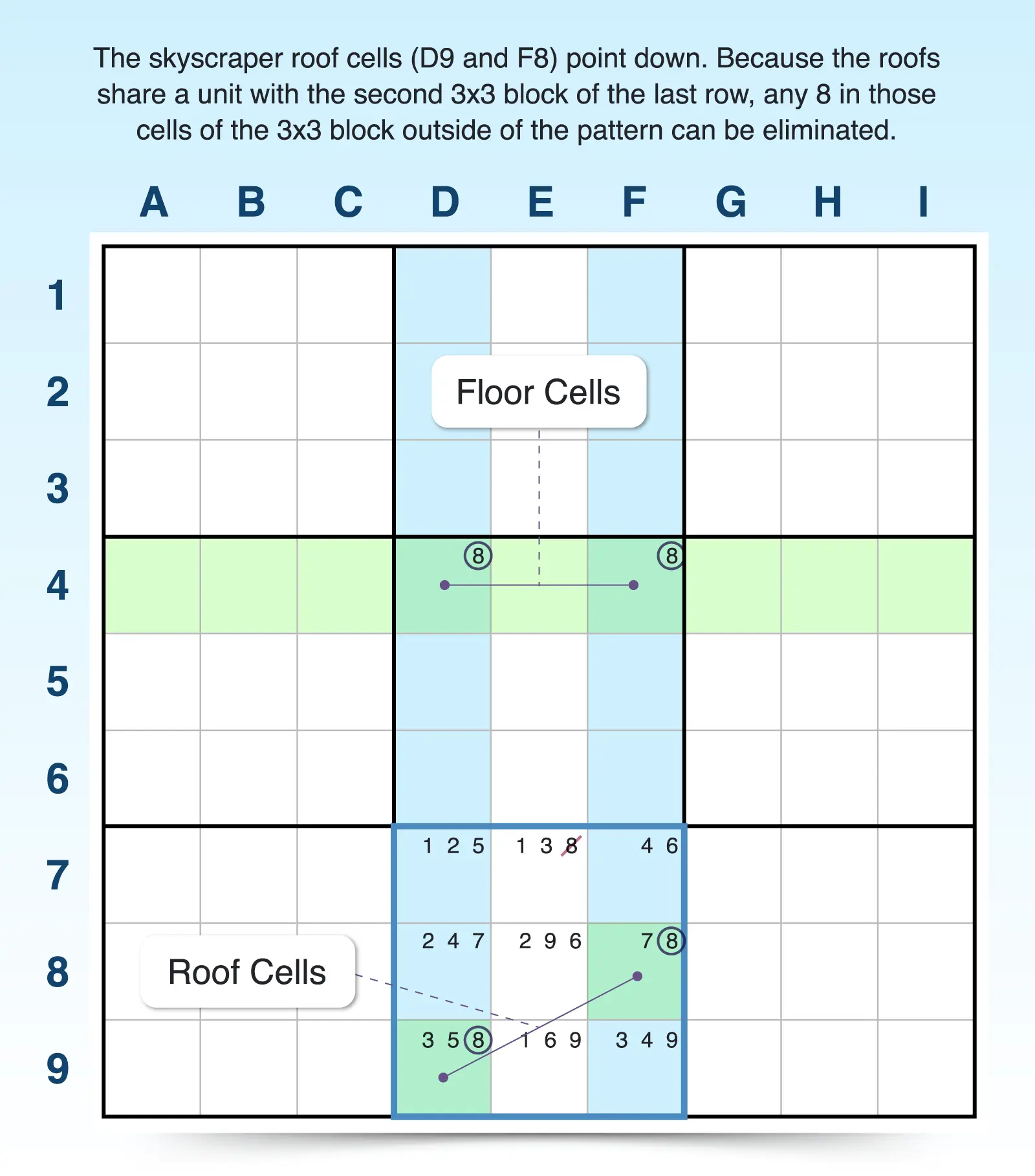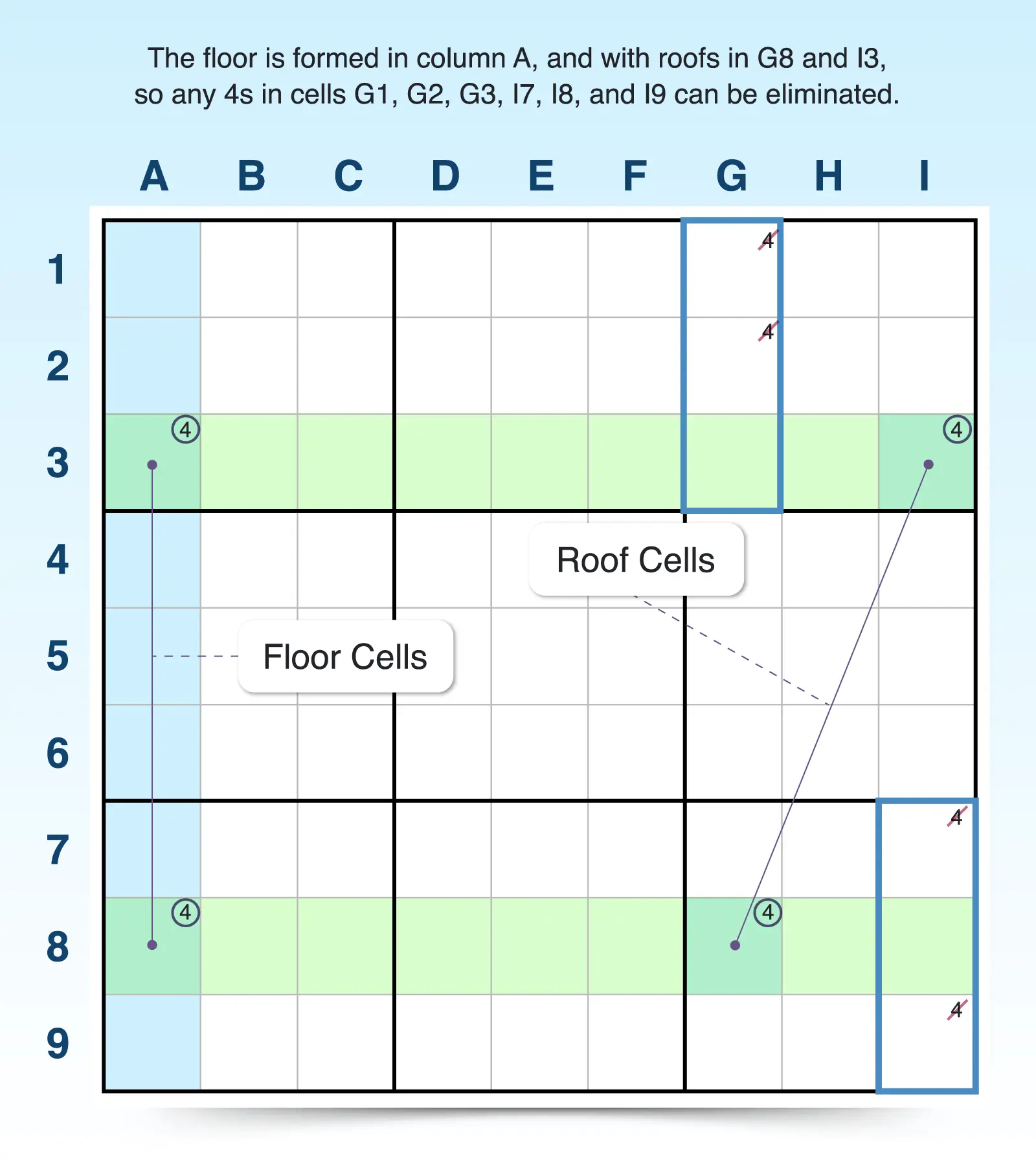Sudoku Skyscraper Technique + Examples
The Sudoku skyscraper technique is a single-candidate Sudoku strategy that recognizes the connections between four cells that contain the same candidate, allowing you to use logic to eliminate candidates from other cells.
You must look for a single candidate that appears in two different columns exactly twice in each (four times total) with two of the cells aligning in one row for the floor and the other two cells falling in a second and third row to form the roof. A skyscraper can also be found in two different rows with a single column forming the floor and two other columns forming the roof of each skyscraper.
The skyscraper works because if the candidate is false in both of the roof cells, then it would be false in the floor cells too, breaking the puzzle’s logic. Therefore, at least one roof cell must be true, so you can eliminate the candidate from any cell that sees both roof cells.
If you’ve used easier strategies for your puzzle but have become stuck, this advanced strategy can help you eliminate candidates to solve the puzzle. If you’re a Sudoku solver who is comfortable finding naked or hidden pairs, you’ll find the skyscraper technique an easy way to level up strategies to solve a range of puzzles from medium to evil.
How to Find Sudoku Skyscrapers
This Sudoku technique is similar to the X-wing strategy, and the pattern is nearly identical except two candidate cells appear in two different columns or rows to create skyscraper roof with different heights.
The simplest way to understand a skyscraper is to see it in vertical form, pointing up, just like you would see a skyscraper in real life. This Sudoku pattern gets its name from the cells lining up to form a floor, like the foundations of a building, and other cells lining up to form the roof of the building.

To find a skyscraper, use pencil marks to note all the candidate possibilities and then follow these steps:
- Find a single candidate that appears exactly twice in two columns (or rows). This means the candidate occupies four total cells, appearing just twice in one column (or row) and appearing twice in another column (or row). For example, candidate 4 appears just twice in column B and just twice again in column H.
- In the two columns, two of the candidate cells must share the same row to form the floor of the skyscraper. Candidate 4 in columns B and H align in row 8 to create the base in this example. If the conjugate pairs appear in rows, two of the four cells must align with the same column to form the floor or base.
- The other two cells must appear in different rows to form a slanted roof. For example, the other candidate 4 for columns B and H do not align in a single row, appearing in B2 and H3 to form the roof. If the conjugate pairs are in rows, the other two cells must be in different columns, to form the roof of the pattern.
- Assess the pattern to find eliminations. Because at least one roof cell (and sometimes both!) must contain the candidate, in this case 4, any cell both of those cells “see” (any cell that shares a unit with both of those cells) can have that candidate eliminated from it. In this case, G2, H2, and I2 share a row with B2 and a 3x3 block with H3, so the 4s in G2 and I2 can be eliminated.
Although you can find skyscraper patterns in all directions and orientations, the simple vertical form is the easiest to visualize. What makes this different from an X-wing is that the X-wing has both sets of candidate pairs lining up to form a rectangle. In comparison, only the base lines up in a skyscraper, not the roof cells.
Sudoku Skyscraper Examples
Skyscrapers can be found oriented in all different directions. Sometimes you may find just one in a puzzle, and at other times, you may find several pointing in all different directions. So recognizing them no matter how they’re oriented can offer a powerful solving strategy, allowing you to eliminate several candidate possibilities.
Sudoku Skyscraper with Vertical Orientation
Vertical skyscrapers can either point up or down, but the bases align within a row. To find a vertically oriented Sudoku skyscraper, follow these steps:
- Find two sets of conjugate pairs with the same candidate appearing in two columns. In this example, columns D and F have 9 appearing just twice in each column.
- Check that two of the cells align in one row to form the base of the skyscraper. Candidate 9 aligns in row 6 of columns D and F to form the base.
- Make sure the other two cells appear in different rows to form the roofs of the skyscraper. If 9 appeared in another single row for columns D and F, it would form an X-wing. Instead, it appears in D3 and F2, forming the roof of a skyscraper.
- Determine eliminations. Because the tips of the skyscraper in cells D3 and F2 both see the second 3x3 block, any 9 in that block not included in the pattern can be eliminated.

You can also find vertical skyscrapers that point down. In this case, the base will be found in an earlier row and the roof will be found in rows nearer to the bottom. To find this type of Sudoku skyscraper, follow these steps:
- Find two sets of conjugate pairs with the same candidate appearing in two columns. In this example, columns D and F have 8 appearing just twice in each column.
- Check that two of the cells align in one row to form the base of the skyscraper. Candidate 8 aligns in row 4 of columns D and F to form the base.
- Make sure the other two cells appear in different rows to form the slanted roof of the skyscraper. If 8 appeared in another single row for columns D and F, it would form an X-wing. Instead, it appears in D9 and F8, forming the tips of a skyscraper.
- Determine eliminations. Because the tips of the skyscraper in cells D9 and F8 both see the middle 3x3 block in the last row of blocks, any 8 in that block not included in the pattern can be eliminated.

Sudoku Skyscraper with Horizontal Orientation
A Sudoku skyscraper with horizontal orientation uses cells aligned in columns for the base instead of rows. It can point its tips either left or right.
To find a horizontally oriented skyscraper that points right, follow these steps:
- Find two sets of conjugate pairs with the same candidate appearing in two rows. In this example, rows 3 and 8 have 4 appearing just twice in each row.
- Check that two of the cells align in one column to form the base of the skyscraper. Candidate 4 aligns in column A to form the base.
- Make sure the other two cells appear in different columns to form the roofs of each skyscraper. The 4 candidates appear in I3 and G8, forming the roof of the skyscraper, pointing to the right of the puzzle.
- Determine eliminations. The tips of the skyscraper in cells I3 and G8 both see (share a unit with) several different cells. G1, G2, and G3 share a column with G8 and a block with I3, so any 4s in those cells can be eliminated. Cells I7, I8, and I9 all share a column with I3 and a block with G8. So any 4s in those cells could also be eliminated.

A horizontal skyscraper can also be found pointing to the left with the base column nearer the right of the puzzle. You can find it by following these steps:
- Find two sets of conjugate pairs with the same candidate appearing in two rows. In this example, rows 3 and 8 have a 5 appearing just twice in each row.
- Check that two of the cells align in one column to form the base of the skyscraper. Candidate 5 aligns in column G to form the base.
- Make sure the other two cells appear in different columns to form the roof of the skyscraper. The 5 candidates appear in C3 and A8, forming the tips of a skyscraper, pointing to the left of the puzzle.
- Determine eliminations. The tips of the skyscraper in cells C3 and A8 both see (share a unit with) several different cells. A1, A2, and A3 share a column with A8 and a block with C3, so any 5s in those cells can be eliminated. Cells C7, C8, and C9 all share a column with C3 and a block with A8. So any 5s in those cells could also be eliminated.

The Sudoku skyscraper strategy can be used after you’ve exhausted other techniques. You may find more than one in a puzzle to help you eliminate candidates when you play Sudoku online. So take your solving skills to the next level with our expert puzzles or solve even more unique puzzles from our archive.